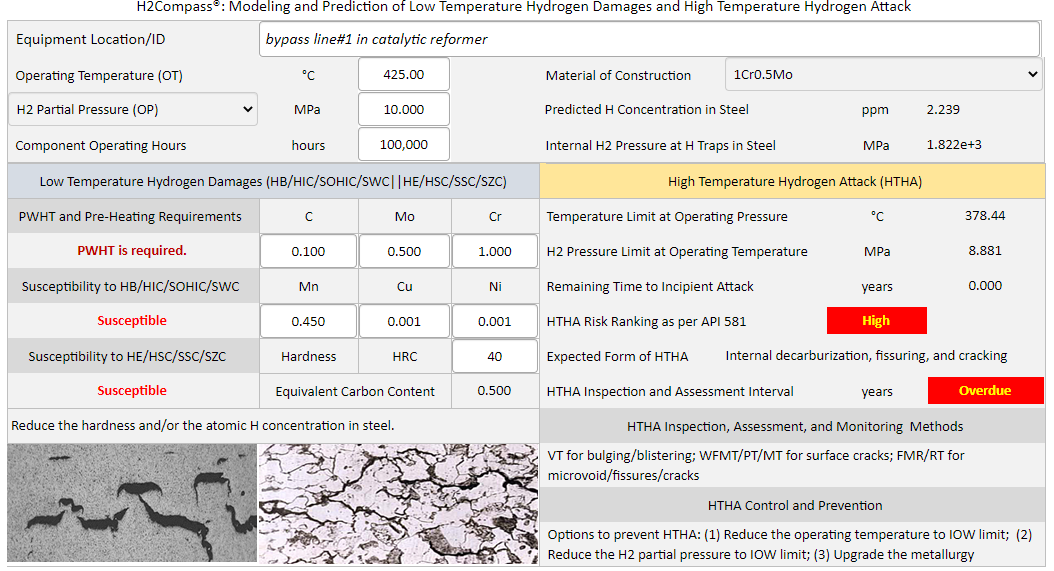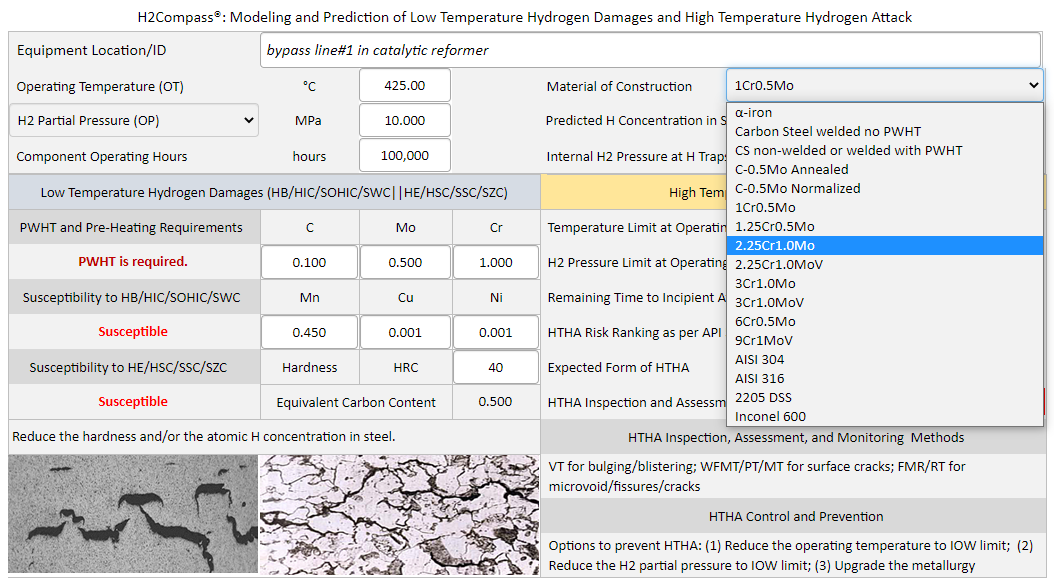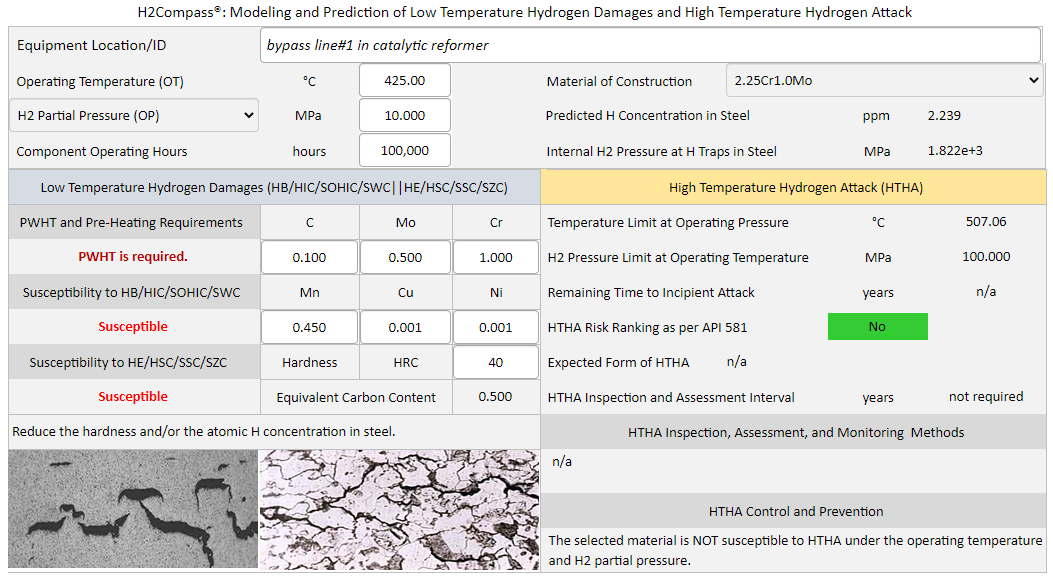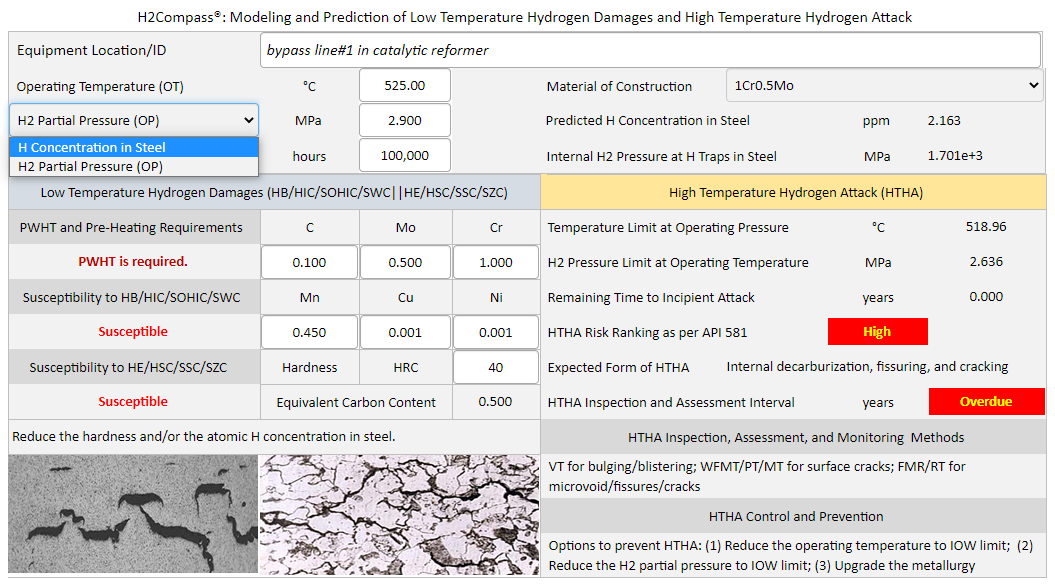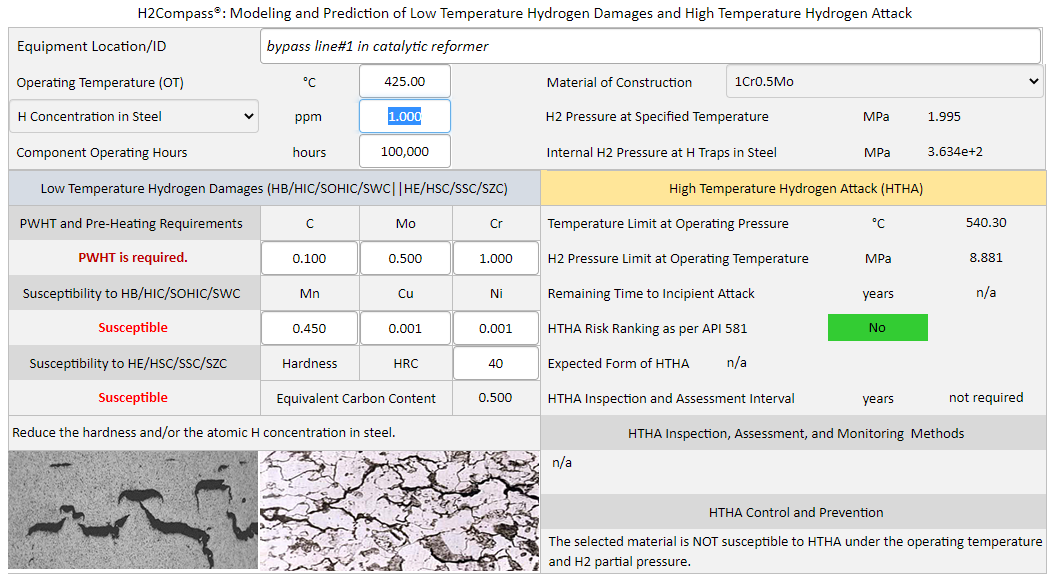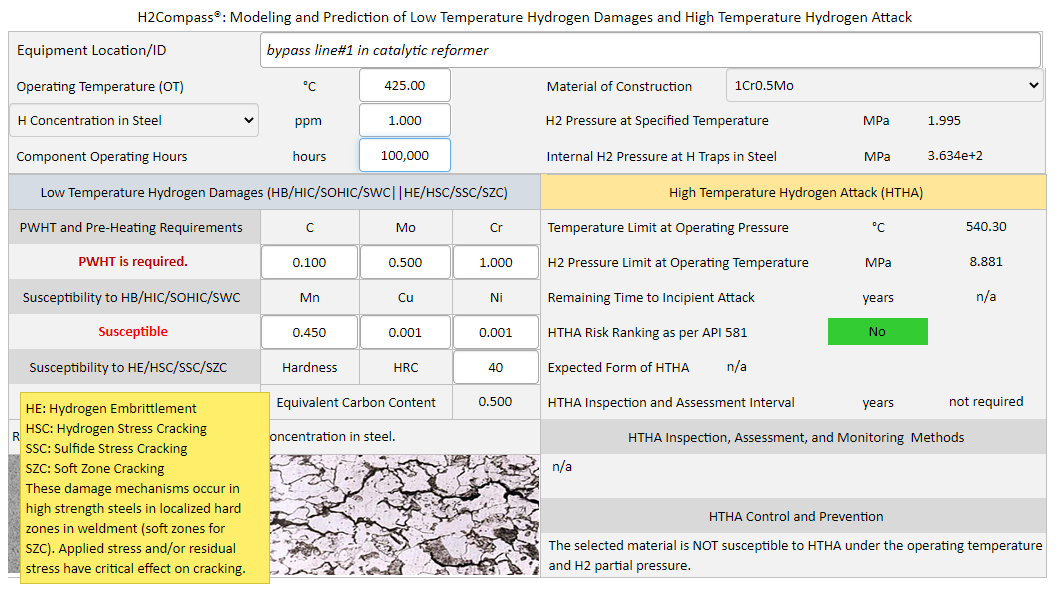|
Home | Consulting | Training | Expert Witness | Failure Analysis | Design Review | Corrosion Test | Corrosion Software | Protective Coatings | Materials Selection | Cathodic Protection | >>> | |
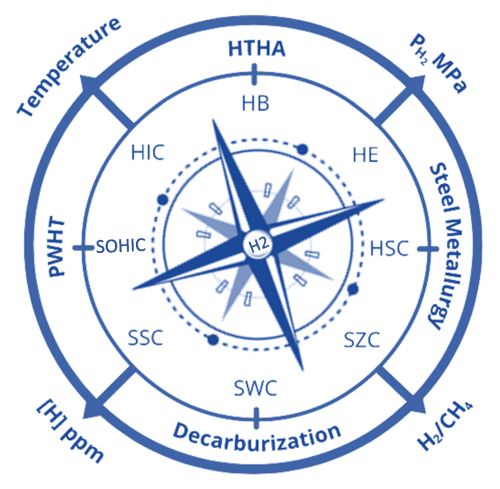 Corrosion Modeling Software and Corrosion Prediction Software Series H2Compass®: Modeling and Prediction of Low Temperature Hydrogen Damages and High Temperature Hydrogen Attack Version 9.23
Anytime Anywhere Any Device Any OS No USB dongles No installation No Browser Plug-ins
|
|
|
Why WebCorr |
Performance Guarantee |
Unparalleled Functionality |
Unmatched Usability |
Any Device Any OS |
Free Training & Support |
CorrCompass |
|
|
Overview and Application Examples of H2Compass |
|
|
Hydrogen atoms regardless of their sources can diffuse into steels and alloys causing hydrogen damages at ambient or low temperature via a number of different mechanisms: hydrogen blistering (HB), hydrogen-induced cracking (HIC), stress-oriented hydrogen-induced cracking (SOHIC), stepwise cracking (SWC), hydrogen embrittlement (HE), hydrogen stress cracking (HSC), sulfide stress cracking (SSC), and soft zone cracking (SZC). At high temperatures, the hydrogen atoms can react with carbon in the steels and alloys causing surface decarburization and/or internal decarburization, fissuring and cracking, a phenomenon known as high temperature hydrogen attack (HTHA).
H2Compass is the only device and OS independent software tool on the market for the modeling and prediction of low temperature hydrogen damages (HB, HIC, SOHIC, SWC, HE, HSC, SZC, SSC) and high temperature hydrogen attack ( HTHA). H2Compass is a cloud-based software that works on any device running any OS without the need for users to install or download anything. Designers, OEM engineers, consultants, operation personnel, maintenance and inspection engineers can quickly and accurately determine: (1) the safe operating temperature limits and hydrogen partial pressure limits for the common metallurgies used for both low and high temperature hydrogen services; (2) the concentration of hydrogen atoms in steels and alloys; (3) the internal hydrogen gas pressure built-up in steels and alloys; (4) the risk of low temperature hydrogen damages; (5) the requirements for post-weld heat treatment (PWHT) and pre-heating; (6) the remaining time to incipient high temperature hydrogen attack (or the incubation period); (7) the risk ranking of high temperature hydrogen attack (HTHA) as per API RP 581; (8) the expected form of HTHA as per API RP 941 under the prevailing operating condition; (9) the recommended HTHA inspection interval under the prevailing operating condition; (10) the recommended effective methods for HTHA inspection, assessment, and monitoring; (11) the recommended HTHA control and prevention methods.
How to determine the operating temperature limits for steels in hydrogen service to avoid high temperature hydrogen attack (HTHA)?
Figure 1 H2Compass predicts low temperatures hydrogen damages and high temperature hydrogen attack (HTHA).
How to select alloy steels for high temperature hydrogen services? How to determine the integrity operating windows for high temperature high pressure hydrogen services? How to assess the susceptibility of an alloy steel to high temperature hydrogen attack (HTHA)? How to assess the cumulative effect of exposure time on the equipment's susceptibility to high temperature hydrogen attack (HTHA)? Under the prevailing temperature and hydrogen partial pressure shown in Figure 1 above, 1Cr0.5Mo is not susceptible to high temperature hydrogen attack (HTHA). However, if the hydrogen partial pressure increases to 10 MPa, this metallurgy becomes susceptible to high temperature hydrogen attack, as shown in Figure 3. H2Compass recommends to reduce operating temperature, or pressure, or change the metallurgy. H2Compass accounts for the cumulative effect of exposure time when determining the remaining time to incipient attack (or the remaining incubation period) and the HTHA risk ranking of a component in high temperature hydrogen services. H2Compass also predicts the expected form of HTHA and the requirement for HTHA inspection and assessment under the prevailing operating conditions.
Figure 3 H2Compass Predicts susceptibility of 1Cr0.5Mo to high temperature hydrogen attack (HTHA).
The integrity operating windows (IOWs) predicted by H2Compass in Figure 3 show that we can reduce the operating temperature to 378°C or reduce the operating pressure to 8.8 MPa. By reducing the operating temperature to the predicted IOWs (Figures 4 and 5), the selected metallurgy has moderate resistance to high temperature hydrogen attack (HTHA), and the remaining time to incipient attack (or the incubation period) is 2.264 years. H2Compass recommends scheduling for the HTHA inspection and assessment.
Figure 4 Reducing the operating temperature to the predicted integrity operating windows (IoWs) for high temperature high pressure hydrogen services.
Figure 5 Reducing the operating pressure to the predicted integrity operating windows (IoWs) for high temperature high pressure hydrogen services.
If adjusting the operating temperature and pressure options are not feasible or desirable, the other option recommended by H2Compass is to change the metallurgy. Figure 6 shows other low alloy steels, stainless steels and alloys available for consideration. Under the operating conditions shown in Figure 3, H2Compass predicts that alloy 1.25Cr0.5Mo is also susceptible to high temperature hydrogen attack (HTHA). The next grade of alloy in the H2Compass database, 2.25Cr1.0Mo, is not susceptible to high temperature hydrogen attack, with the safe operating temperature limit of 507°C (Figure 7).
Figure 6 H2Compass for evaluation and verification of alloy selection for high temperature high pressure hydrogen services.
Figure 7 H2Compass predicts the safe operating temperature limit of alloy steels for high temperature high pressure hydrogen services.
H2Compass is a powerful software that can provide instant answers to the following questions: How to select alloy steels for resistance to low temperature hydrogen damages? How to calculate hydrogen concentration in steels? How to calculate internal hydrogen gas pressure in steels? How to determine if post-weld heat treatment (PWHT) or pre-heating is required? How to assess the susceptibility of an alloy steel to low temperature hydrogen damages such as hydrogen blistering (HB), hydrogen-induced cracking (HIC), stress-oriented hydrogen-induced cracking (SOHIC), stepwise cracking (SWC), hydrogen embrittlement (HE), hydrogen stress cracking (HSC), sulfide stress cracking (SSC), and soft zone cracking (SZC)?
When hydrogen partial pressure is used as input, H2Compass computes the hydrogen concentration in steel at the prevailing operating temperature, and the internal hydrogen pressure at hydrogen traps in the steel upon cooling to ambient temperature. When the hydrogen concentration in steel is used as input (Figure 8), H2Compass computes the hydrogen gas pressure at the prevailing operating temperature, and the internal hydrogen pressure at hydrogen traps in the steel upon cooling to ambient temperature (Figure 9).
Figure 8 Hydrogen concentration in steel is used as input to assess the risk of low temperature hydrogen damages.
Figure 9 H2Compass predicts the susceptibility of a steel to low temperature hydrogen damages.
At 1 ppm hydrogen concentration in the low alloy 1Cr0.5Mo (Figure 9), the internal hydrogen gas pressure at hydrogen traps is predicted to be 363 MPa. H2Compass makes an overall assessment of other factors such as the hardness and equivalent carbon content of the steel to determine the susceptibility to low temperature hydrogen damages and the requirements for post-weld heat treatment (PWHT). Mouse-over tips help users of H2Compass to accurately carry out the modeling and prediction of low temperature hydrogen damages and high temperature hydrogen attack (Figure 10).
Figure 10 H2Compass predicts the concentration of dissolved hydrogen in steels and alloys and the susceptibility to low temperature hydrogen damages.
The powerful applications of H2Compass are truly unlimited in engineering design, materials selection, process operation, inspection and maintenance, modeling and prediction of low temperature hydrogen damages and high temperature hydrogen attack (HTHA).
Click here to contact us for licensing details and experience the power of H2Compass. |
|
H2Compass, giving you the right directions in the Modeling and Prediction of Low Temperature Hydrogen Damages and High Temperature Hydrogen Attack (HTHA) |
|
|
Home | Contact Us | PDF |
Copyright © 1995-2024. All rights reserved. |

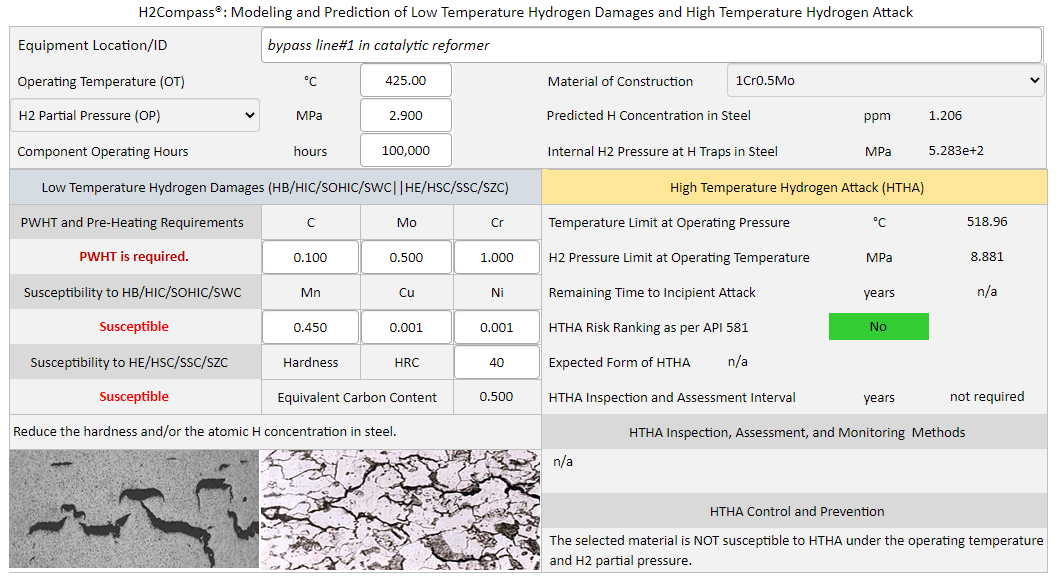
 Under the prevailing operating conditions
shown in Figure 1 above, the atomic hydrogen concentration in the selected alloy, 1Cr0.5Mo, is predicted to be 1.206 ppm. The safe temperature limit for this alloy steel at the prevailing operating pressure (OP) of 2.90MPa is 518.96°C, the safe hydrogen pressure limit at the prevailing operating temperature (OT) of 425°C is 8.881 MPa. H2Compass determines that there is no risk of HTHA as this alloy is not susceptible to HTHA at the prevailing operating conditions. At low temperatures, however, this alloy is susceptible to hydrogen blistering (HB), hydrogen-induced cracking (HIC), stress-oriented hydrogen-induced cracking (SOHIC), stepwise cracking (SWC), hydrogen embrittlement (HE), hydrogen stress cracking (HSC), sulfide stress cracking (SSC), and soft zone cracking (SZC). Post-weld heat treatment is required to minimize the risk of low temperature hydrogen damages. H2Compass also calculates the internal hydrogen gas pressure at hydrogen traps in steels. Under the prevailing conditions shown in Figure 1 above, the buildup of internal hydrogen gas pressure upon cooling from 425°C (or for a steel containing 1.206 ppm hydrogen) can reach 528 MPa. This internal pressure can cause hydrogen blistering (HB), as shown in Figure 2.
Under the prevailing operating conditions
shown in Figure 1 above, the atomic hydrogen concentration in the selected alloy, 1Cr0.5Mo, is predicted to be 1.206 ppm. The safe temperature limit for this alloy steel at the prevailing operating pressure (OP) of 2.90MPa is 518.96°C, the safe hydrogen pressure limit at the prevailing operating temperature (OT) of 425°C is 8.881 MPa. H2Compass determines that there is no risk of HTHA as this alloy is not susceptible to HTHA at the prevailing operating conditions. At low temperatures, however, this alloy is susceptible to hydrogen blistering (HB), hydrogen-induced cracking (HIC), stress-oriented hydrogen-induced cracking (SOHIC), stepwise cracking (SWC), hydrogen embrittlement (HE), hydrogen stress cracking (HSC), sulfide stress cracking (SSC), and soft zone cracking (SZC). Post-weld heat treatment is required to minimize the risk of low temperature hydrogen damages. H2Compass also calculates the internal hydrogen gas pressure at hydrogen traps in steels. Under the prevailing conditions shown in Figure 1 above, the buildup of internal hydrogen gas pressure upon cooling from 425°C (or for a steel containing 1.206 ppm hydrogen) can reach 528 MPa. This internal pressure can cause hydrogen blistering (HB), as shown in Figure 2.
